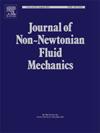Viscoelastic instability in viscosity-stratified channel flow with viscous heating effects
IF 2.8
2区 工程技术
Q2 MECHANICS
引用次数: 0
Abstract
The linear instability analysis of the isothermal pressure-driven flow of an Oldroyd-B fluid through a plane channel with viscous heating effects is carried out. The temperature dependence of the viscosity of solute, solvent, and polymeric solution is described using the Nahme law. There is no external temperature imposed in the system, the temperature gradient arises purely from frictional dissipation. The Reynolds number , Nahme number , Peclet number , Deborah number , the ratio of solvent to solution viscosity , and the dimensionless heating coefficient for polymeric solution are the dimensionless parameters that modify the instability characteristics of the flow. The Chebyshev spectral collocation method is employed to numerically solve the generalised eigenvalue problem. The viscous heating in the flow is characterised by Nahme number. It is observed that the unstable area under the neutral stability curves increases as we increase the viscous heating effects. Moreover, it is found that there exist a minimum and maximum threshold value of Deborah number for which linear instability persists. An increase in the value expands the parameter range for instability. The Peclet number and dimensionless heating coefficient do not alter the linear stability characteristics.
具有粘性加热效应的粘层通道流的粘弹性不稳定性
对具有粘性热效应的Oldroyd-B流体在平面通道中的等温压力驱动流动进行了线性不稳定性分析。用纳姆定律描述了溶质、溶剂和聚合物溶液粘度的温度依赖性。系统中没有外力施加温度,温度梯度纯粹由摩擦耗散产生。雷诺数(Re)、Nahme数(Na)、Peclet数(Pe)、Deborah数(De)、溶剂/溶液粘度比(β)和聚合物溶液的无因次加热系数(α)是改变流动不稳定特性的无因次参数。采用切比雪夫谱配置法对广义特征值问题进行了数值求解。流动中的粘性加热用纳姆数表示。观察到中性稳定性曲线下的不稳定面积随着粘性加热效应的增大而增大。此外,还发现存在一个持续存在线性不稳定性的最小和最大黛博拉数阈值。β值的增加扩大了不稳定性的参数范围。Peclet数(Pe)和无因次加热系数(α)不改变线性稳定性特性。
本文章由计算机程序翻译,如有差异,请以英文原文为准。
求助全文
约1分钟内获得全文
求助全文
来源期刊
CiteScore
5.00
自引率
19.40%
发文量
109
审稿时长
61 days
期刊介绍:
The Journal of Non-Newtonian Fluid Mechanics publishes research on flowing soft matter systems. Submissions in all areas of flowing complex fluids are welcomed, including polymer melts and solutions, suspensions, colloids, surfactant solutions, biological fluids, gels, liquid crystals and granular materials. Flow problems relevant to microfluidics, lab-on-a-chip, nanofluidics, biological flows, geophysical flows, industrial processes and other applications are of interest.
Subjects considered suitable for the journal include the following (not necessarily in order of importance):
Theoretical, computational and experimental studies of naturally or technologically relevant flow problems where the non-Newtonian nature of the fluid is important in determining the character of the flow. We seek in particular studies that lend mechanistic insight into flow behavior in complex fluids or highlight flow phenomena unique to complex fluids. Examples include
Instabilities, unsteady and turbulent or chaotic flow characteristics in non-Newtonian fluids,
Multiphase flows involving complex fluids,
Problems involving transport phenomena such as heat and mass transfer and mixing, to the extent that the non-Newtonian flow behavior is central to the transport phenomena,
Novel flow situations that suggest the need for further theoretical study,
Practical situations of flow that are in need of systematic theoretical and experimental research. Such issues and developments commonly arise, for example, in the polymer processing, petroleum, pharmaceutical, biomedical and consumer product industries.

 求助内容:
求助内容: 应助结果提醒方式:
应助结果提醒方式:


